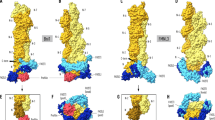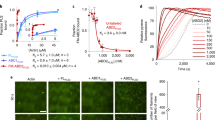Abstract
Profilin, a ubiquitous low molecular weight (13,000–15,000 Mr) actin binding protein, regulates the formation of F-actin structures in vivo, and is localized to specific cellular regions through interaction with proline-rich sequences. Here we report the 2.2 Å X-ray structure of the complex between human platelet profilin (HPP) and a decamer of L-proline (L-Pro10). The L-Pro10 peptide adopts a left-handed type II poly-L-proline helix (PPM) and binds to a highly conserved patch of aromatic amino acids on the surface of prof ilin. The peptide and actin binding sites reside on orthogonal surfaces, and L-Pro10 binding does not result in a conformational rearrangement of HPP. This structure suggests a mechanism for the localization of prof ilin and its actin-related activities to sites of actin filament assembly in vivo.
This is a preview of subscription content, access via your institution
Access options
Subscribe to this journal
Receive 12 print issues and online access
$189.00 per year
only $15.75 per issue
Buy this article
- Purchase on Springer Link
- Instant access to full article PDF
Prices may be subject to local taxes which are calculated during checkout
Similar content being viewed by others
References
Haarer, B.K. et al. Purification of profilin from Saccharomyces cerevisiae and analysis of profilin-deficient cells. J. Cell Biol. 110, 105–114 (1990).
Cooley, L., Verheyen, E. & Ayers, K. chickadee encodes a profilin required for intercellular cytoplasm transport during Drosophila oogenesis. Cell 69, 173–184 (1992).
Balasubramanian, M.K., Hirani, B.R., Burke, J.D. & Gould, K.L. The Schizosaccharomyces pombe cdc3+ gene encodes a profilin essential for cytokinesis. J. Cell Biol. 125, 1289–1301 (1994).
Finkel, T., Theriot, J.A., Dise, K.R., Tomaselli, G.F. & Goldschmidt-Clermont, P.J. Dynamic actin structures stabilized by profilin. Proc. Natl. Acad. Sci. USA 91, 1510–1514 (1994).
Pollard, T.D. & Cooper, J.A. Actin and actin binding proteins. A critical evaluation of mechanisms and functions. Annu. Rev. Biochem. 55, 987–1035 (1986).
Goldschmidt-Clermont, P.J. et al. The control of actin nucleotide exchange by thymosin β-4 and profilin: A potential regulatory mechanism for actin polymerization in cells. Mol. Biol. Cell. 3, 1015–1024 (1992).
Carlier, M.F., Jean, C., Rieger, K.J., Lenfant, M. & Pantaloni, D. Modulation of the interaction between G-actin and thymosin β-4 by the ATP/ADP ratio. Proc. Natl. Acad. Sci. USA. 90, 5034–5038 (1993).
Pantaloni, D. & Carlier, M.F. How profilin promotes actin filament assembly in the presence of thymosin β-4. Cell, 75, 1007–1013 (1993).
Gertler, F.B., Niebuhr, K., Reinhard, M., Wehland, J. & Soriano, P. Mena, a relative of VASP and Drosophila Enabled is implicated in the control of microfilament dynamics. Cell 87, 227–239 (1996).
Chakraboty, T. et al. A focal adhesion factor directly linking intracellularly motile Listeria monocytogenes and Listeria ivanovii to the actin based cytoskeleton of mamalian cells. EMBO J. 14, 1314–1321 (1995).
Reinhard, M. et al. The proline-rich focal adhesion and microfilament protein VASP is a ligand for profilin. EMBO J. 14, 1583–1589 (1995).
Evangalista, M. et al. Bni1p, a yeast Formin linking Cdc42p and the actin cytoskeleton during polarized morphogenesis. Science. 276, 118–122 (1997).
Chang, F., Drubin, D. & Nurse, P. cdc12p, a protein required for cytokinesis in fission yeast, is a component of the cell division ring and interacts with profiling. J. Cell Biol 137, 169–182 (1997).
Watanabe, N. et al. p140mDia, a mammalian homolog of Drosophila diaphanous, is a target protein for Rho small GTPase and is a ligand for profilin. EMBO J. 16, 3044–3056 (1997).
Petersen, J., Weilguny, D., Egel, R. & Nielsen, O. Characterization of fusl of Schizosaccharomyces pombe: A developmentally controlled function needed for conjugation. Mol Cell Biol 15, 3697–3707 (1995).
Manseau, L., Calley, J. & Phan, H. Profilin is required for posterior patterning of the Drosophila oocyte. Development. 122, 2109–2116 (1996).
Marhoul, J.F. & Adams, T.H. Identification of developmental regulatory genes in Aspergillus nidulans by overexpression Genetics 139, 537–547 (1995).
Chan, D.C., Bedford, M.T. & Leder, P. Formin binding proteins bear WWP/WW domains that bind proline-rich peptides and functionally resemble SH3 domains. EMBO J. 15, 1045–1054 (1996).
Petrella, E.C., Machesky, L.M., Kaiser, D.A. & Pollard, T.D. Structural requirements and thermodynamics of the interaction of proline peptides with profilin. Biochemistry 35, 16535–16543 (1996).
Björkegren, C., Rozycki, M., Schutt, C.E., Lindberg, U. & Karlsson, R. Mutagenesis of human profilin locates its poly (L-proline) binding site to a patch of aromatic amino acids. FEBS Lett. 333, 123–126 (1993).
Haarer, B., Petzold, A.S. & Brown, S.S. Mutational analysis of yeast profilin. Mol. Cell. Biol. 13, 7864–7873 (1993).
Kaiser, D. & Pollard, T.D. Characterization of actin and poly-L-proline binding sites of Acanthamoeba profilin with monoclonal antibodies and by mutagenesis. J. Mol. Biol. 256, 89–107 (1996).
Metzler, W.J., Bell, A.J., Ernst, E., Lavoie, T.B. & Mueller, L. Identification of the poly-L-proline binding site on human profilin. J. Biol. Chem. 269, 4620–4625 (1994).
Archer, S.J., Vinson, V.K., Pollard, T.D. & Torchia, D.A. Elucidation of the poly-L-proline binding site in Acanthamoeba profilin I by NMR spectroscopy. FEBS Lett. 337, 145–151 (1994).
Perelroizen, I., Marchand, J., Blanchoin, L., Didry, D. & Carlier, M.F. Interaction of profilin with G-actin and poly-L-proline. Biochemistry 33, 8472–8478 (1994).
Schutt, C.E., Myslik, J.C., Rozycki, M.D., Goonesekere, N.C. & Lindberg, U. The structure of crystalline profilin-β-actin. Nature 365, 810–816 (1993).
Theriot, J., Rosenblatt, J., Portnoy, D., Goldschmidt-Clermont, P.J. & Mitchison, T. Involvement of profilin in the actin based motility of L. monocytogenes in cells and cell free extracts. Cell 76, 505–517 (1994).
Southwick, F. & Purich, D.L. Intracellular pathogenesis of listeriosis. New England J. Med. 334, 770–776 (1996).
Pollard, T.D. Actin cytoskeleton. Missing link for intracellular bacterial motility? Curr. Biol. 5, 837–840 (1995).
Ren, R., Mayer, B.J., Cichetti, P. & Baltimore, D. Identification of a ten-amino acid proline-rich SH3 binding site. Science 259, 1157–1161 (1993).
Yu, H. et al. Structural basis for the binding of proline-rich peptides to SH3 domains. Cell 76, 933–945 (1994).
Chen, H.I. & Sudol, M. The WW domain of YES-associated protein binds a proline-rich ligand that differs from the consensus established for Src homology 3-binding modules. Proc. Natl. Acad. Sci. USA 92, 7819–7823 (1995).
Macias, M.I. et al. Structure of the WW domain of a kinase associated protein complexed with a proline-rich peptide. Nature 382, 646–649 (1996).
Sudol, M. Structure and function of the WW domain. Prog. Biophys. Molec. Biol. 65, 113–132 (1996).
Rabanal, F., Ludeuid, M.D., Pons, M. & Giralt, E. CD of proline-rich polypeptides: application to the study of the repetitive domain of maize glutelin-2. Biopolymers. 33, 1019–1028 (1993).
Williamson, M.P. The structure and function of proline-rich peptides in proteins. Biochem J. 297, 249–260 (1994).
Viguera, A.R., Arrondo, J.L.R., Musacchio, A., Saraste, M. & Serrano, L. Characterization of the interaction of natural proline-rich peptides with five different SH3 domains. Biochemistry 33, 10925–10933 (1994).
Flory, P.J. Statistical Mechanics of Chain Molecules (Oxford University Press, New York, 1988).
Jardetzky, T.S. et al. Crystallographic analysis of endogenous peptides associated with HLA-DR1 suggests a common polyproline ll-like conformation for bound peptides. Proc. Natl. Acad. Sci. USA 93, 734–738 (1996).
Lim, W.A., Richards, F.M. & Fox, R.O. Structural determinants of peptide-binding orientation and of sequence specificity in SH3 domains. Nature 372, 375–379 (1994).
Feng, S., Chen, J.K., Yu, H., Simon, J.A. & Schreiber, S.L. Two binding orientations for peptides to the Src SH3 domain: development of a general model for SH-3 ligand interactions. Science 266, 1241–1247 (1994).
Sudol, M. The WW module competes with the SH3 domain? TIBS 21, 161–163 (1996).
Alexandropoulos, K., Cheng, G. & Baltimore, D. Proline-rich sequences that bind to Src homology domains with individual specificities. Proc. Natl. Acad. Sci USA 92, 3110–3114 (1995).
Fedorov, A.A., Pollard, T.D. & Almo, S.C. Purification, characterization and crystallization of human platelet profilin expressed in E. coli . J. Mol. Biol. 241, 480–482 (1994).
Li, E., Locke, B., Yang, N., Ong, D.E. & Gordon, J.I. Characterization of rat cellular retinol-binding protein II expressed in Escherichia coli . J. Biol. Chem. 262, 13773–13779 (1987).
Kabsch, W. Evaluation of single crystal X-ray diffraction data from a position sensitive detector. J. Appl. Crystallogr. 21, 916–924 (1988).
Furey, W. & Swamininthan, S. PHASES- a program package for processing and analysis of diffraction data for macromolecules. Acta Crystallogr. 18, 73 (1990).
Brünger, A.T. X-PLOR (version 3.1) Manual. Yale University, New Haven, CT (1993).
Berne, B. & Pecora, R. Dynamic Light Scatteging. New York, John Wiley and Sons (1976).
Patkowski, A., Seils, J., Buβ, F., Jockusch, B.M. & Dorfmüller, T.H. Size and shape parameter of the actin binding protein profilin in solution: a depolarized and polarized dynamic light scattering study. Biopolymers 30, 219–222 (1990).
Nicholls, A.J. GRASP manual. Graphical representation and analysis of surface properties. (Columbia University, New York, 1993).
Evans, S.V. SETOR: hardware lighted three dimensional solid model representation of macromolecules J.Mol. Graph. 11, 134–138 (1993).
Fedorov, A.A., Ball, T., Mahoney, N.M., Valenta, R. & Almo, S.C. The molecular basis for allergen cross reactivity: crystal structure and IgE-epitope mapping of birch pollen profilin. Structure 5, 33–45 (1997).
Wu, X. et al. Structural basis for the specific interaction of lysine-containing proline-rich peptides with the N-terminal SH3 domain of c-Crk. Structure 3, 215–226 (1995).
Wishart, D.S., Willard, L., Richards, F.M. & Sykes, B.D. VADAR: A comprehensive program suite for protein structural analysis (http://www.pence.ualberta.ca/mc/bds/vader.html).
Author information
Authors and Affiliations
Rights and permissions
About this article
Cite this article
Mahoney, N., Janmey, P. & Almo, S. Structure of the profilin-poly-L-proline complex involved in morphogenesis and cytoskeletal regulation. Nat Struct Mol Biol 4, 953–960 (1997). https://doi.org/10.1038/nsb1197-953
Received:
Accepted:
Published:
Issue Date:
DOI: https://doi.org/10.1038/nsb1197-953
This article is cited by
-
A structural model of the profilin–formin pacemaker system for actin filament elongation
Scientific Reports (2022)
-
Profilin1 biology and its mutation, actin(g) in disease
Cellular and Molecular Life Sciences (2017)
-
Discovery of a Biological Mechanism of Active Transport through the Tympanic Membrane to the Middle Ear
Scientific Reports (2016)
-
Capping protein regulators fine-tune actin assembly dynamics
Nature Reviews Molecular Cell Biology (2014)
-
Platelets and cancer: a casual or causal relationship: revisited
Cancer and Metastasis Reviews (2014)



